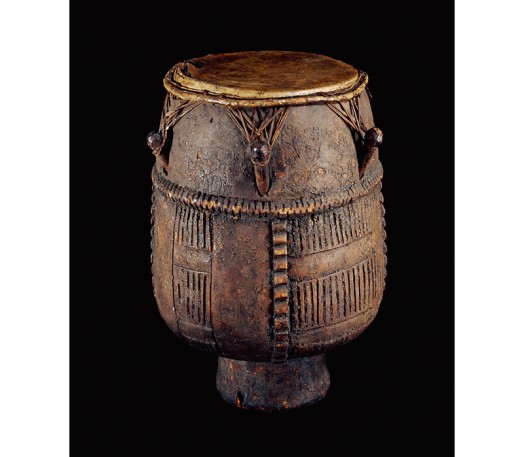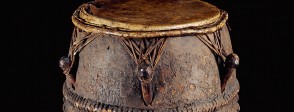
The drum in West Africa
The drum is made from carved wood with what is probably deer skin stretched over. In the eighteenth century it was labelled as an ‘American Indian Drum’. It was not until 1906 that a curator at the British Museum realised that it was West African. Recent tests have shown that the drum is carved from the wood of the tree cordia africana which grows in West Africa. The pegs and cords that hold the skin of the drum tight also come from trees and plants that grow in the region; the deer skin is North American. The drum is thought to have been made in the early-18th century by the Akan people in present-day Ghana.
Drums played a vital role in Akan culture, not only as musical instruments at times of celebration, but also as a form of communication. The Akan drum was a ‘talking drum’. Skilled drummers could replicate the tones, punctuation and accents of the Akan language in order to send messages from village to village. In this way, Akan people could be called to a celebration or to war.
Slavery
Slavery was a long-established feature of Akan states such as the Asante kingdom, which by the end of the AD 1600s controlled a large empire in the region. Slaves were acquired as captives from enemies in warfare and the slave population therefore grew as a result of Asante territorial expansion. In the 17th and 18th centuries, the Portuguese, and later the Dutch and British, established a profitable trade in gold and slaves with the Asante. The guns supplied by the Europeans fuelled internal conflict in West Africa and thus increased the supply of slaves.
Between the 16th and the 19th centuries, it is estimated that around twelve million Africans were transported from the trading stations of West Africa to the Americas, with millions more dying en route. Although Britain started trading in slaves later than Portugal or Spain, it became the biggest slave trading nation during the 18th century. The first African slaves arrived in Britain’s North American colonies in 1619. By the early 1700s, African slaves formed the most profitable trade between West African rulers and British traders. Enslaved Africans were transported on British-owned ships in order to provide labour for the sugar, rice, tobacco and cotton plantations of the West Indies and North America. This was one of the biggest and most inhumane forced migrations in the history of the world.
The drum in America
It is thought that the Akan drum was taken to Virginia on a slave ship, but not by an enslaved African, as slaves were not allowed to carry possessions with them. The drum may have been given to a ship’s captain as a gift or, since we know that the sons of Asante chiefs sometimes accompanied the voyages as part of their education, perhaps it was taken to America by one of them.
We cannot be certain whether or how the drum was ever used after it had left West Africa. The middle passage of the transatlantic slave trade from West Africa to North America took around six weeks. During that time the enslaved Africans were shackled below deck in the hold of the ship. Disease spread quickly in the cramped and insanitary conditions and many Africans died during the journey. It was in the economic interests of the slave traders to keep the slaves in good health so they sometimes brought the slaves up on deck and forced them to ‘dance’ in order to give them exercise and to prevent depression. It is possible that the drum was used for this purpose.
Since the skin on the drum is probably deer skin, the original skin must have been replaced in North America and so it is likely that the drum was used there. It is known that on some plantations slaves were allowed to drum and make music for themselves when they were not working. However, in the 18th century, plantation owners began to fear that drums could be used to incite revolt and some colonies prohibited their use. If the drum was ever played by slaves on the plantation it may, at some point, have been confiscated by the plantation owner. Drums might have been banned during the era of slavery in North America, but the music and dance of Africa would become a powerful force in modern American culture. The story of this Akan drum is one of both despair and of hope.
More information
Akan drum
Information on the Akan drum from the British Museum’s A History of The World in 100 Objects: listen to the programme or read the transcript.
http://www.bbc.co.uk/ahistoryoftheworld/objects/iTEvLsbQRxilYjAO5TZ3mA
Kingdom of Asante
A documentary programme on the Kingdom of Asante presented by Guy Casley-Hayford.
http://www.youtube.com/watch?v=SOExGlwMnw4
Digging for slaves
Digging for slaves: a BBC Chronicle archaeology programme first broadcast in 1989.
http://www.bbc.co.uk/archive/chronicle/8627.shtml
Africa and the Transatlantic Slave Trade
Africa and the Transatlantic Slave Trade - an introduction by Hakim Adi for the BBC website.
http://www.bbc.co.uk/history/british/abolition/africa_article_01.shtml
Slavery and Empire
A BBC Radio 4 In Our Time programme on Slavery and Empire.
http://www.bbc.co.uk/programmes/p00548jd
Understanding Slavery Initiative
Resources from the Understanding Slavery Initiative.
http://www.understandingslavery.com/
Resources from the National Archives
http://www.nationalarchives.gov.uk/slavery/about.htm#transatlantic
Legacies of British slave-ownership
A database from University College London
http://www.ucl.ac.uk/lbs/
More information
-
Akan drum
Information on the Akan drum from the British Museum’s A History of The World in 100 Objects: listen to the programme or read the transcript.
Source: bbc.co.uk
-
Kingdom of Asante
A documentary programme on the Kingdom of Asante presented by Guy Casley-Hayford.
Source: youtube.com
-
Digging for slaves
Digging for slaves: a BBC Chronicle archaeology programme first broadcast in 1989.
Source: bbc.co.uk
-
Africa and the Transatlantic Slave Trade
Africa and the Transatlantic Slave Trade - an introduction by Hakim Adi for the BBC website.
Source: bbc.co.uk
-
Slavery and Empire
A BBC Radio 4 In Our Time programme on Slavery and Empire.
Source: bbc.co.uk
-
Understanding Slavery Initiative
Resources from the Understanding Slavery Initiative.
Source: understandingslavery.com
-
Resources from the National Archives
Source: nationalarchives.gov.uk
-
Legacies of British slave-ownership
A database from University College London
Source: ucl.ac.uk


